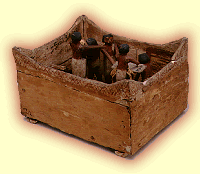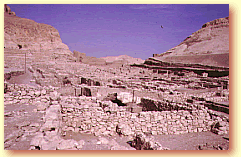|
|
|
|
|
Hieroglyphs were reserved for official and prestigious texts, but everyday texts were written in a cursive version of the script (hieratic). Probably less than 1% of the population was literate during most of the Pharaonic period, and so most people would have had to turn to a professional scribe. Scribes were central to every aspect of Egypt's administration civil, military and religious as can be seen in this model granary (right) showing a scribe in action. A thorough training in scribal skills was essential for any young man with professional or political aspirations.
|
 Model granary from a tomb, about 1900 BC |
|
 The workers' village, Deir el Medina. Photo: Nigel Strudwick |
The village of Deir el-Medina (left) housed the craftsmen working on the royal tombs at Thebes. Records about the daily lives of a number of scribes from this community survive. For example, Qenherkhepshef, a 'Scribe of the Tomb', living around 1250 BC, is well known from his documents as a learned but imperiously crafty man, with remarkably messy handwriting. |
